Glass blocks provide excellent insulation and privacy with a thick, textured design, making them ideal for decorative door panels. Tempered glass offers superior strength, safety, and clarity, ensuring durability and resistance to impact in door applications.
Table of Comparison
| Feature | Glass Block | Tempered Glass |
|---|---|---|
| Material Type | Thick, individual glass cubes | Heat-treated, safety glass |
| Strength | Moderate impact resistance | 4-5 times stronger than standard glass |
| Safety | Blocks direct impact, but can crack | Shatters into small, safe pieces |
| Privacy | Opaque, diffuses light | Clear or frosted options available |
| Installation | Heavy, requires mortar or framing | Lightweight, fits standard door frames |
| Thermal Insulation | Good insulation properties | Moderate insulation |
| Maintenance | Low, durable surface | Easy to clean, vulnerable to scratches |
| Common Uses | Decorative doors, partitions | Entry doors, security doors |
Introduction: Choosing the Right Door Material
Glass block doors offer exceptional durability and privacy by combining thick, translucent blocks that diffuse light while maintaining security. Tempered glass doors provide enhanced safety with heat-treated, shatter-resistant panels that are clearer and allow maximum visibility. Selecting between glass block and tempered glass depends on balancing aesthetic preferences, security needs, and light transmission requirements.
Glass Block vs Tempered Glass: A Quick Overview
Glass blocks provide enhanced privacy, sound insulation, and a decorative, textured appearance while offering moderate impact resistance. Tempered glass is known for its superior strength, safety features such as shattering into small granular pieces, and clear visibility, making it ideal for high-traffic door applications. Choosing between glass block and tempered glass depends on the balance between aesthetic preference, safety requirements, and functional needs in door design.
Aesthetic Appeal: Design Possibilities
Glass block doors offer a unique, textured aesthetic that enhances privacy while allowing light diffusion, making them ideal for creating artistic, geometric patterns in contemporary or traditional designs. Tempered glass doors provide a sleek, transparent appearance that maximizes natural light and offers versatile design options, including frosted, tinted, or patterned finishes for a modern and minimalist look. Both materials support customization, but glass blocks excel in adding sculptural depth, whereas tempered glass emphasizes clean lines and seamless integration with metal or wooden frames.
Strength and Durability Comparison
Tempered glass offers superior strength and impact resistance compared to glass blocks, making it highly durable under heavy stress and thermal changes. Glass blocks, while thicker and providing excellent compression strength, are more rigid and prone to cracking under direct impact. Tempered glass's ability to shatter into small, blunt pieces enhances safety, whereas glass blocks rely on their mass and mortar for durability in door applications.
Security Features: Safety Considerations
Glass blocks offer enhanced security with their thick, solid structure, making them difficult to break and providing superior resistance to forced entry. Tempered glass, while significantly stronger than standard glass due to heat treatment, can still shatter into small, less harmful pieces under high impact, balancing safety with vulnerability. For doors requiring both security and safety, glass blocks provide robust protection, whereas tempered glass offers a safer breakage pattern but may need additional reinforcement.
Thermal and Acoustic Insulation
Glass block doors provide superior thermal insulation due to their thick, multi-layered structure that reduces heat transfer and enhances energy efficiency. Tempered glass doors, while stronger and safer due to heat treatment, offer less soundproofing and thermal resistance compared to glass blocks. For optimal acoustic insulation and maintaining indoor temperature, glass block doors outperform tempered glass options.
Privacy Levels: Transparency vs Obscurity
Glass block doors offer enhanced privacy through their textured, opaque surfaces that distort visibility while allowing light to pass, making them ideal for areas requiring limited transparency. Tempered glass doors provide clear transparency with superior strength and safety but offer minimal privacy, often necessitating additional treatments like frosting or blinds to obscure visibility. Choosing between glass block and tempered glass hinges on the balance between desired privacy levels and aesthetic preferences, with glass blocks excelling in obscurity and tempered glass favoring openness.
Installation Process and Challenges
Glass block installation requires meticulous alignment and heavy mortar application, often demanding skilled labor and extended curing times, making it more labor-intensive compared to tempered glass. Tempered glass doors offer simpler installation with pre-fabricated panels and standard framing systems, reducing on-site labor and time but necessitating precise handling to avoid breakage. Challenges for glass blocks include limited design flexibility and weight considerations, whereas tempered glass requires expert handling due to its brittleness despite its increased strength.
Cost Analysis: Initial and Long-Term Investment
Glass block doors typically have a higher initial cost due to material and installation expenses but offer excellent durability and low maintenance, reducing long-term investment. Tempered glass doors are generally more affordable upfront and provide enhanced safety with impact resistance, yet may require more frequent replacements or repairs over time. Evaluating both options involves balancing upfront budget constraints against durability and maintenance costs to optimize overall financial efficiency.
Best Applications: When to Choose Each Option
Glass block offers excellent privacy and insulation, making it ideal for bathroom or exterior doors where security and light diffusion are priorities. Tempered glass provides superior strength and safety with a clear, modern aesthetic, perfect for entry doors or interior spaces where visibility and impact resistance are essential. Choosing between glass block and tempered glass depends on the need for security, clarity, insulation, and design preference.

Infographic: Glass block vs Tempered glass for Door
 azmater.com
azmater.com